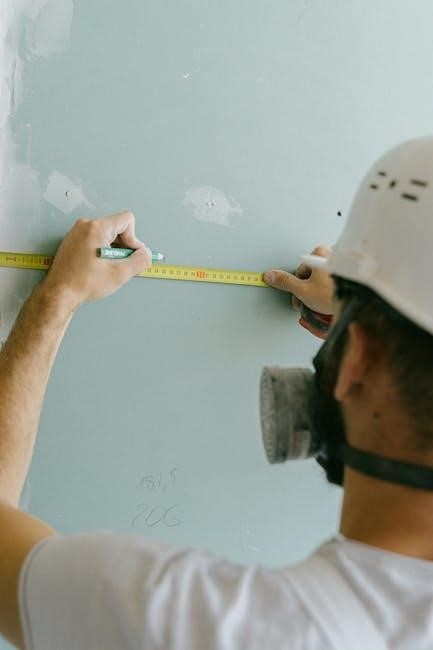
Manual D is an ACCA standard for duct design, ensuring efficient HVAC systems by sizing ducts based on load calculations and equipment selection, balancing airflow for optimal comfort and energy efficiency.
1.1 What is Manual D?
Manual D is a comprehensive set of guidelines developed by the Air Conditioning Contractors of America (ACCA) to assist HVAC professionals in designing ductwork systems that effectively distribute air throughout a home. It is part of a broader set of industry standards, including Manual J (for load calculations) and Manual S (for equipment selection). Manual D focuses on sizing and layout of ducts to ensure the correct amount of heating and cooling is delivered to each room, promoting energy efficiency and indoor comfort.
1.2 Importance of Manual D in HVAC Design
Manual D is crucial in HVAC design as it ensures duct systems are sized and configured correctly, optimizing airflow and energy efficiency. Proper duct design prevents energy losses, reduces utility bills, and enhances system performance. It also ensures even distribution of heating and cooling, improving indoor comfort and system longevity. By following Manual D guidelines, HVAC professionals can design systems that meet industry standards, reducing callbacks and ensuring customer satisfaction.
1.3 Brief Overview of ACCA Standards (Manual J, Manual S, Manual D)
ACCA standards, including Manuals J, S, and D, provide a comprehensive framework for HVAC system design. Manual J calculates heating and cooling loads, Manual S selects appropriate equipment, and Manual D designs duct systems. Together, these manuals ensure systems are energy-efficient, correctly sized, and balanced for optimal performance. They guide professionals through precise calculations and best practices, ensuring comfort, efficiency, and system longevity. Adhering to these standards is essential for achieving high-quality HVAC installations that meet industry benchmarks and customer expectations.

The Process of Manual D Calculation
The Manual D process begins with load calculations using Manual J, followed by equipment selection via Manual S, and concludes with detailed duct design and layout planning.
2.1 Load Calculation Using Manual J
Manual J provides the foundation for Manual D by calculating heating and cooling loads, considering factors like insulation, window orientation, and climate. This step determines the required CFM for each room, ensuring the HVAC system meets the home’s specific needs. Accurate load calculations are crucial for proper equipment sizing and duct design, preventing issues like uneven temperatures or energy inefficiency. By analyzing these factors, Manual J ensures the HVAC system is tailored to the home’s unique conditions, setting the stage for efficient duct sizing in Manual D.
2.2 Equipment Selection Using Manual S
Manual S is a critical step following load calculations, guiding the selection of appropriate HVAC equipment. It ensures the chosen furnace, AC, or heat pump matches the home’s heating and cooling needs. By evaluating factors like system type and duct configuration, Manual S helps determine the correct airflow rates. Proper equipment selection is vital for system efficiency and performance. It provides the CFM requirements needed for Manual D duct sizing, ensuring the system operates effectively. Accurate selection prevents issues like inadequate heating or cooling, promoting a balanced and efficient HVAC system design. This step bridges load calculations with duct design seamlessly.
2.3 Duct Design and Layout
Duct design and layout are critical for ensuring proper airflow distribution in HVAC systems. Manual D provides guidelines for sizing ducts based on factors like room size, insulation, and window orientation; The process involves balancing airflow to meet the cooling and heating needs of each room. Proper duct layout minimizes pressure drops, ensuring efficient system performance; Techniques like zoning and branching are used to distribute air effectively. Duct sealing and insulation are also emphasized to prevent energy losses. By following Manual D, professionals can design duct systems that deliver conditioned air quietly and efficiently, ensuring even temperature distribution and reducing energy costs.

Key Concepts in Manual D
Manual D introduces key principles for duct sizing, pressure drop calculations, and air velocity management, ensuring efficient HVAC performance through precise calculations and system design.
3.1 Duct Sizing Principles
Duct sizing principles in Manual D focus on balancing airflow, pressure, and velocity to ensure efficient HVAC performance. Proper sizing minimizes energy loss and noise, while maintaining comfort. Calculations consider factors like room loads, equipment capacity, and system layout. The goal is to achieve optimal airflow distribution, ensuring each room receives the correct amount of conditioned air. Incorrect sizing can lead to reduced system efficiency and discomfort. Manual D provides precise methods to calculate duct dimensions, ensuring a well-designed system that meets energy efficiency and comfort standards.
3.2 Pressure Drop Calculations
Pressure drop calculations are critical in Manual D to ensure efficient airflow through duct systems. Higher pressure drops increase fan energy use and reduce system performance. Manual D provides formulas to calculate pressure losses in straight ducts, fittings, and registers. Factors like duct material, size, and airflow rate are considered. Accurate calculations help design systems within acceptable pressure limits, optimizing energy efficiency and system longevity. Proper pressure drop management ensures consistent airflow delivery, maintaining comfort and reducing operational costs. Ignoring these principles can lead to system inefficiencies and higher energy bills. Manual D guidelines ensure precise calculations for optimal HVAC performance.
3.3 Air Velocity and Its Impact on Duct Design
Air velocity plays a crucial role in duct design, as it directly impacts system efficiency and noise levels. Proper velocity ensures airflow is distributed evenly without excessive noise. Manual D recommends specific velocity ranges to maintain optimal performance, typically between 600-900 feet per minute for residential systems. Higher velocities can lead to noise issues, while lower velocities may reduce system efficiency. Balancing velocity with duct size and layout ensures consistent airflow delivery, preventing hot or cold spots. Accurate velocity calculations are essential for designing systems that meet comfort and energy efficiency goals, ensuring a quiet and effective HVAC operation;

Manual D Calculation Steps
Manual D calculations involve gathering data, determining duct CFM, sizing supply and return ducts, calculating fittings, and optimizing layout for efficient airflow and system performance.
4.1 Gather Necessary Data (Room Sizes, Insulation, Window Orientation)
Gathering accurate data is the first step in Manual D calculations. This includes room dimensions, insulation levels in walls and ceilings, window types, sizes, orientations, and shading. Detailed information about skylights, glass doors, and other fenestrations is also essential. This data ensures proper system design, balancing airflow, and distributing heating and cooling evenly. Accurate information is critical for efficient HVAC performance, energy savings, and comfort. Missing or incorrect data can lead to poor system efficiency and increased energy costs, making this step foundational for successful duct design.
4.2 Determine Duct CFM Based on Equipment Selection
Duct CFM is determined by matching the selected HVAC equipment’s airflow requirements with the calculated heating and cooling loads from Manual J. This ensures the system delivers the correct airflow for optimal performance. The CFM must align with the equipment’s capacity and the duct system’s design, considering factors like static pressure and pressure drop. Proper CFM ensures efficient airflow, balancing heating and cooling distribution, and maintaining system efficiency. Accurate calculation is crucial to prevent issues like insufficient heating/cooling or excessive energy consumption.
4.3 Size Supply and Return Ducts
Sizing supply and return ducts is critical for ensuring balanced airflow and proper system performance. Using Manual D guidelines, duct sizes are determined based on calculated CFM, pressure drop, and equipment specifications. The process involves evaluating room-by-room load requirements, ensuring even distribution of conditioned air. Proper sizing prevents issues like noise, inefficiency, or uneven heating/cooling. Factors such as insulation, window orientation, and equipment capacity are considered. Accurate duct sizing ensures optimal system efficiency, maintaining comfort and minimizing energy waste. It requires careful calculation and adherence to ACCA standards to achieve a well-designed duct system.
4.4 Calculate Fittings and Equivalent Lengths
Calculating fittings and equivalent lengths is essential for accurate duct system design. Fittings like elbows, tees, and dampers introduce pressure drops, impacting airflow. Equivalent lengths convert fitting resistances into straight duct lengths for uniform system performance. Manual D provides charts and formulas to determine these values, ensuring precise calculations. Proper consideration of these factors prevents system inefficiencies and noise issues. By integrating fitting and equivalent length data, HVAC professionals can design balanced duct systems that meet performance and efficiency standards, ensuring optimal airflow distribution throughout the home.
Tools and Software for Manual D Calculations
Manual D calculations rely on specialized tools, including worksheets and third-party software, to streamline duct sizing and layout processes, ensuring accuracy and efficiency in HVAC design.
5.1 Manual D Worksheets
Manual D worksheets are essential for systematic calculations, providing structured templates to input data like room sizes, insulation, and equipment specs. They help in determining duct CFM, sizing, and layout, ensuring compliance with ACCA standards. These worksheets simplify complex calculations, reducing errors and saving time. By following the step-by-step format, professionals can accurately design duct systems that meet specific load requirements, ensuring optimal airflow and energy efficiency. Regular updates to these worksheets reflect the latest industry standards, making them indispensable for HVAC professionals aiming for precise and efficient duct designs.
5.2 Third-Party Software for Duct Design
Third-party software streamlines Manual D calculations, offering advanced tools to design and size duct systems efficiently. Programs like Manual D Duct Calculator and others provide pre-built formulas and workflows, reducing manual errors. These tools allow HVAC professionals to input specific data, such as room dimensions and equipment specs, to generate precise duct layouts. Many software options integrate with ACCA standards, ensuring compliance. They also offer features like real-time simulations and automated sizing, saving time and improving accuracy. By leveraging these tools, professionals can create optimized duct systems tailored to specific projects, enhancing overall performance and energy efficiency.
5.3 Best Practices for Using Calculation Tools
Using Manual D calculation tools effectively requires adherence to best practices. Always verify input data accuracy to ensure reliable results. Regularly update software to access the latest ACCA standards and features. Cross-check calculations with Manual J and S data to maintain consistency. Document all steps for future reference and compliance. Professionals should also undergo training to fully utilize tool capabilities. Finally, perform field tests post-installation to validate design performance, ensuring the system operates as intended. These practices maximize efficiency, accuracy, and system performance, aligning with industry standards and homeowner expectations.

Applications of Manual D in Residential HVAC
Manual D ensures optimal air distribution, enhances energy efficiency, and improves indoor comfort in residential HVAC systems by accurately sizing ducts, balancing airflow, and minimizing energy waste.
6.1 Optimizing Air Distribution
Manual D ensures balanced airflow by accurately sizing ducts, preventing under or over-supply of conditioned air to rooms. This optimization leads to consistent temperatures, reducing hot or cold spots. Proper duct design enhances system performance and comfort, ensuring energy efficiency. By following Manual D guidelines, HVAC professionals can achieve optimal air distribution, improving indoor air quality and system longevity. Tools like worksheets and software aid in precise calculations, while best practices ensure compliance with ACCA standards. Properly sized registers and grilles maintain air velocity within recommended limits, minimizing noise and maximizing system effectiveness, ultimately enhancing overall residential comfort and energy efficiency.
6.2 Ensuring Energy Efficiency
Manual D plays a crucial role in energy efficiency by ensuring duct systems are properly sized and balanced. Oversized ducts can lead to increased energy consumption, while undersized systems may struggle to meet demand. By calculating precise duct sizes and layouts, Manual D helps minimize energy waste. Reduced pressure drops and optimized airflow contribute to lower HVAC system energy usage. Properly designed ductwork ensures equipment operates efficiently, reducing utility costs and environmental impact. Compliance with Manual D guidelines is essential for creating energy-efficient HVAC systems, aligning with modern sustainability goals and improving overall system performance.
6.3 Enhancing Indoor Comfort
Manual D ensures optimal indoor comfort by balancing airflow distribution across all rooms. Proper duct sizing and layout prevent hot or cold spots, maintaining consistent temperatures. By aligning duct design with load calculations, Manual D guarantees that each room receives the right amount of conditioned air. This balance enhances overall comfort and reduces noise from uneven airflow. Properly designed systems also minimize drafts and ensure quiet operation, creating a more pleasant indoor environment. By following Manual D guidelines, HVAC professionals can deliver systems that meet homeowner comfort expectations while maintaining energy efficiency and performance.

Common Mistakes to Avoid in Manual D Calculations
Common mistakes include incorrect pressure drop assumptions, oversizing or undersizing ducts, and ignoring air velocity recommendations, which can lead to inefficient systems and poor performance.
7.1 Incorrect Pressure Drop Assumptions
Incorrect pressure drop assumptions can lead to inefficient duct systems, reduced airflow, and increased energy costs. Assuming incorrect static pressure or ignoring friction losses can result in oversized or undersized ducts. This often causes poor system performance, increased noise, and higher operational costs. ACCA guidelines recommend precise calculations for pressure drops, especially in dampers, registers, and fittings. Using standardized values without proper verification is a common mistake. Proper field measurements and calculations ensure accurate pressure drop assumptions, optimizing system efficiency and performance. Always refer to ACCA Manual D guidelines to avoid such errors and ensure reliable duct design outcomes.
7.2 Oversizing or Undersizing Ducts
Oversizing or undersizing ducts is a common mistake that can significantly impact HVAC system performance. Oversized ducts may cause low air velocities, reducing system efficiency and increasing energy costs. Undersized ducts can lead to high pressure drops, noisy operation, and inadequate airflow delivery. Proper sizing using Manual D ensures optimal airflow rates and pressure drops. It is crucial to follow ACCA guidelines and perform accurate load calculations to avoid these errors. Correct duct sizing balances system performance, energy efficiency, and comfort, making it essential for a well-designed HVAC system. Always double-check calculations to ensure ducts are appropriately sized for the specific application.
7.3 Ignoring Air Velocity Recommendations
Ignoring air velocity recommendations is a critical mistake in Manual D calculations. Proper air velocity ensures efficient airflow, minimizes noise, and maintains system performance. Low velocity can result in inadequate cooling or heating, while excessive velocity may cause noise and energy waste. Manual D provides guidelines for optimal velocity ranges to balance comfort and efficiency. HVAC professionals must adhere to these recommendations to ensure proper system operation. Conducting thorough field tests and using ACCA guidelines can help avoid this error, ensuring a well-performing and energy-efficient HVAC system. Always prioritize air velocity checks during the duct design process.

Best Practices for HVAC Professionals
Follow ACCA guidelines, regularly update knowledge on Manual D, and conduct field tests post-installation to ensure accurate duct designs and optimal system performance.
8.1 Following ACCA Guidelines
Following ACCA guidelines is crucial for accurate Manual D calculations. These standards ensure duct systems are designed for optimal airflow, efficiency, and comfort. By adhering to ACCA protocols, professionals guarantee compliance with industry best practices, reducing errors and enhancing system performance. ACCA guidelines provide detailed methods for duct sizing, pressure drop calculations, and layout configurations, ensuring systems meet specific load requirements. Using ACCA-approved tools and resources, such as worksheets and software, helps professionals maintain consistency and accuracy. Compliance with these guidelines not only improves system functionality but also aligns with energy efficiency standards, benefiting both homeowners and HVAC professionals.
8.2 Regularly Updating Knowledge on Manual D
Regularly updating knowledge on Manual D ensures HVAC professionals stay current with industry advancements. ACCA periodically revises standards to reflect new technologies and best practices, making ongoing education essential. Professionals should engage in training sessions, workshops, and webinars to understand updates in duct design methodologies. Staying informed about new tools and software, such as updated calculation programs, enhances accuracy and efficiency. Continuous learning also helps professionals address evolving challenges, such as energy efficiency requirements and innovative system designs. By keeping their skills sharp, HVAC experts can deliver superior results, ensuring systems are optimized for performance and comfort.
8.3 Conducting Field Tests Post-Installation
Field tests after installation ensure HVAC systems perform as designed. Professionals verify airflow rates, static pressures, and system balances to confirm compliance with Manual D calculations. Testing involves measuring CFM at registers and grilles, ensuring they match design specifications. Pressure drop assessments across ducts and components are also critical. Correcting any discrepancies maintains system efficiency and comfort. Post-installation testing validates the accuracy of Manual D designs, ensuring optimal performance and energy efficiency. This step is vital for identifying and addressing potential issues before they impact system operation and homeowner satisfaction;
Manual D is essential for efficient HVAC design, ensuring proper duct sizing and airflow distribution. Its guidelines remain vital for advancing duct design and calculation methodologies in the future;
9.1 Summary of Manual D’s Role in HVAC Design
Manual D is a critical ACCA standard for designing efficient HVAC systems by sizing ducts accurately. It ensures proper airflow distribution, balancing heating and cooling across rooms, enhancing comfort and energy efficiency. By following Manual D, professionals achieve optimal duct layouts, reducing energy waste. This guide complements Manual J and Manual S, forming a comprehensive design process. Adhering to Manual D ensures systems operate at peak performance, delivering consistent temperatures and improved indoor air quality. Its principles are indispensable for modern HVAC design, making it a cornerstone of industry best practices for residential comfort and efficiency.
9.2 The Future of Duct Design and Calculations
The future of duct design and calculations lies in advancing technology and sustainability. AI and machine learning will enhance precision, while eco-friendly materials and energy-efficient systems gain prominence. Tools like Manual D will integrate with BIM and smart home technologies, streamlining processes. Professionals must adapt to these innovations, embracing continuous learning. The focus will shift to smarter, more sustainable designs, ensuring optimal performance with minimal environmental impact. As HVAC evolves, Manual D will remain a cornerstone, guiding the industry toward a future of efficiency, comfort, and environmental responsibility.